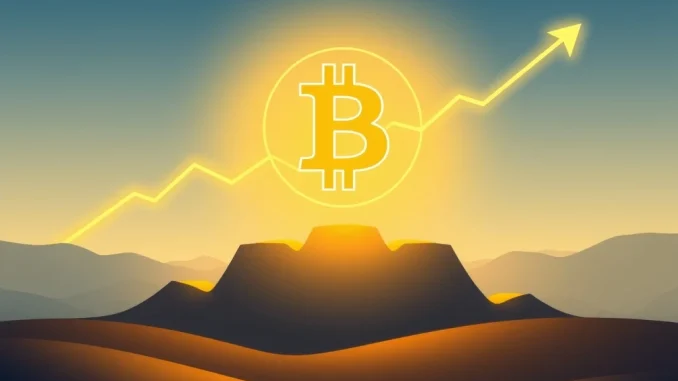
Are you wondering what’s next for Bitcoin after its recent all-time high? Despite navigating a consolidation phase, on-chain data offers a compelling glimpse into the market’s underlying strength. A remarkably low percentage of Bitcoin supply is currently active, signaling that long-term holders are largely unwilling to sell, even at elevated prices. This suggests that the current bull cycle may have significant room to run, defying expectations of an immediate market top.
Understanding Bitcoin’s Active Supply: A Key Indicator
One of the most telling metrics for understanding market dynamics is the ‘% Supply Active in the Past 180 Days.’ This indicator measures the portion of Bitcoin that has moved on-chain within the last six months, giving insight into selling pressure from recent profit-takers or long-term holders finally distributing their coins. The lower this percentage, the stronger the conviction of existing crypto holders.
Historically, significant bull market tops have been preceded by a surge in this metric, indicating widespread profit-taking and distribution. For instance:
- In Spring 2024, as Bitcoin approached $70,000, the % Supply Active surged to 20%.
- By December 2024, when Bitcoin broke through $100,000, it hit 18%.
Fast forward to July 2025, and the current reading stands at a mere 2.4%. While this is an improvement from negative territory, it remains drastically below historical peaks. This stark contrast suggests that the market is far from entering a heightened distribution phase, where a large portion of the supply would be actively sold.
Why Are Long-Term Holders Still HODLing?
The reluctance of long-term Bitcoin holders to sell, even after Bitcoin reached a new all-time high above $123,000 and currently fluctuates between $117,000 and $120,000, is a powerful bullish signal. Bitcoin researcher Axel Adler Jr. emphasizes that the gradual rise in % Supply Active reflects a shift in holder behavior, but at a pace that lags significantly behind previous cycles.
“The current trajectory suggests we are far from entering a heightened distribution phase,” Adler notes. He anticipates a potential climb to 8-10% active supply if Bitcoin sustains levels above $120,000, with the 18-20% threshold only re-emerging in a late-cycle context. This analysis aligns with the observation that long-term holders are not yet incentivized to sell, providing crucial structural support for further Bitcoin price appreciation.
What Does This Mean for Future Bitcoin Price Action?
The muted supply activity contrasts sharply with historical patterns. While some analysts maintain ambitious targets of $250,000 or even $1 million, others, like Glassnode’s James Check, express caution about achieving $200,000 by 2025 due to weak buying volume. However, these diverging views do not negate the broader signal of prolonged holder retention. The fundamental indicator of low active supply continues to suggest underlying strength.
Recent movements, such as $150 million in dormant Bitcoin re-entering circulation via SpaceX, indicate shifting sentiment but fall short of the aggressive outflows seen in prior bull runs. Even large holders, like the “Satoshi-Era” group, who shifted $9.5 billion earlier in the year, have not shown significant profit-taking, further reinforcing the idea that conviction remains high.
Navigating Current Market Trends: What to Watch
The current market trends suggest that widespread selling pressure remains distant, giving Bitcoin more room to appreciate before reaching a critical inflection point. For investors, monitoring the 8-10% active supply benchmark is crucial. This level could indicate an evolving market dynamic, potentially signaling the beginning of a more active distribution phase.
If accumulation resumes and new capital continues to enter the market, the stage could be set for another significant upward move, provided existing holders continue to resist near-term profit-taking. This period of consolidation, coupled with low active supply, could be a precursor to the next leg up in the bull market.
In conclusion, the current state of Bitcoin’s active supply offers a compelling narrative: long-term holders are confident, and the market may still be in the early to mid-stages of its bull cycle. While price predictions vary, the on-chain data points to a strong underlying conviction that could propel Bitcoin to new heights. Keeping an eye on the % Supply Active will be key to understanding when the true distribution phase begins.
Frequently Asked Questions (FAQs)
What does ‘active supply’ mean in Bitcoin?
Active supply refers to the percentage of the total Bitcoin supply that has moved on-chain within a specific timeframe, typically the last 180 days. It’s a key metric for gauging how much Bitcoin is being actively traded or distributed by holders.
Why is a low active supply considered bullish for Bitcoin?
A low active supply indicates that a significant portion of Bitcoin holders, particularly long-term investors, are not selling their coins. This suggests strong conviction and reduced selling pressure, which can provide structural support for the Bitcoin price to trend higher.
How does the current 2.4% active supply compare to previous bull markets?
In previous major bull market peaks (e.g., Spring 2024 and December 2024), the active supply surged to 18-20%. The current 2.4% is significantly lower, suggesting the market is far from a widespread distribution phase seen at historical tops.
What is the significance of the 8-10% active supply benchmark?
According to experts like Axel Adler Jr., if Bitcoin sustains levels above $120,000, the active supply might climb to 8-10%. This benchmark could signal an evolving market dynamic and potentially indicate the start of a more active distribution phase, though still far from a late-cycle top.
Are large Bitcoin holders selling their coins?
The article notes that despite some shifts, like $150 million in dormant Bitcoin re-entering circulation or the ‘Satoshi-Era’ group moving $9.5 billion earlier, there has been no significant profit-taking observed from large holders that would indicate aggressive outflows typical of a market top.
Should investors rely solely on active supply for investment decisions?
While active supply is a powerful on-chain indicator, investors should always consider a holistic view of the market, including macroeconomic factors, trading volume, technical analysis, and other on-chain metrics. No single indicator guarantees future price movements, but it offers valuable insight into holder behavior and underlying market strength.



